How To Calculate Hysteresis In Matlab

Introduction
Hysteresis is a source of incertitude that affects many types of measurement equipment and their associated measurement results. With a quick search on the internet, you volition find a lot studies defended to hysteresis. If you take a wait at manufacturer manuals and datasheets, you may observe specifications related to hysteresis. All the same, you won't see hysteresis commonly included in laboratory's incertitude budgets.
When I read many of the studies bachelor, most of them were related to electrical hysteresis and magnetism. It wasn't until searched for mechanical or elastic hysteresis that I brainstorm to find the information beneficial to most calibration and testing laboratories.
Nevertheless, you will non find many papers specifically studying the effects on measurement devices.
Therefore, I decided to create a guide on hysteresis for scale and testing labs, so you could consider information technology in your uncertainty budgets (if it is applicative).
In this guide, y'all will learn the following information most hysteresis:
- What is hysteresis
- Why is hysteresis of import
- When should you include hysteresis
- How to reduce hysteresis
- Formulas to calculate hysteresis
- How to perform a hysteresis exam
- How to summate hysteresis
What is Hysteresis
According to the Oxford English Dictionary, hysteresis is the phenomenon where the value of a physical belongings lags behind changes in the effect causing it.
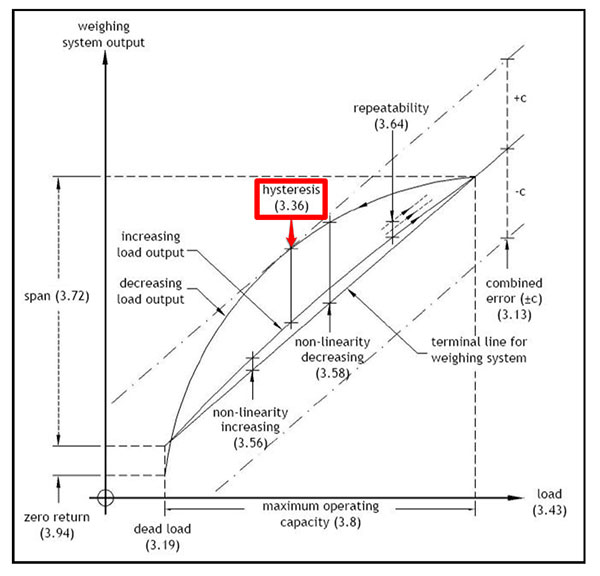
Co-ordinate to NASA, hysteresis is the response of a structure to loading and unloading that is unremarkably associated with energy loss nether load cycling and hence damping with the construction.
This is the definition that I similar the near.
For you, information technology means that your measurement result when increasing load, forcefulness, pressure, etc is not the same as your result when decreasing load, force, force per unit area, etc. If you are not taken this into consideration when performing tests or calibrations, so you will add boosted dubiety to your results.
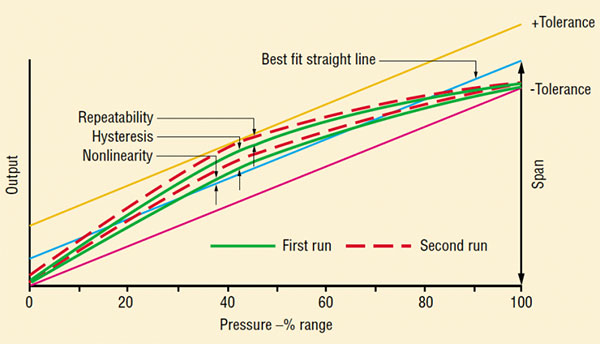
If this is occurring with your exam and measurement equipment and affecting your measurement results, you may desire to consider hysteresis in your incertitude budgets.
Why is Hysteresis Important
Hysteresis is important because it contributes to uncertainty in measurement results.
If you are not aware of the effects of hysteresis and how to reduce them, you could obtain erroneous results when performing measurements. Worse yet, you lot could be passing this mistake on to your client's measurement results without either ane of yous knowing virtually it.
In some cases, it may not be a big deal for you. However, when you incorporate risk and cost into the evaluation, your thoughts may alter.
Endeavour assigning a cost to your errors. If your measurement errors resulted in a monetary loss (associated with failures, repairs, downtime, or nonconforming work), would you retrieve differently virtually hysteresis?
Would your perspective change if your measurement errors afflicted human health or life?
While this is non typically the case, yous should be enlightened of the risks and consequences of measurement errors and the negative impacts they can cause. This is why hysteresis is of import.
In case yous are curious, just do a Google search on hysteresis. You will be amazed by how many studies have been published on the topic.
When Should You Include Hysteresis
Consider hysteresis in your uncertainty analysis when it is unremarkably known to bear upon your type of measurement system or have an impact on your measurement results.
Hysteresis tin occur in various types of measurement equipment and systems, including:
- Electric measurement equipment,
- Mechanical measurement equipment, and
- Thermodynamic measurement equipment.
Review your equipment's manufacturer manuals and specifications to find out whether or not hysteresis is idea to have an event on your measurement results. If information technology is non specified past the manufacturer, you may find more data past reading your examination methods or calibration procedures.
If hysteresis is mentioned (and given its own specification), it is most likely significant and should be included in your incertitude analysis. If not, you may be able to omit it from your incertitude budget.
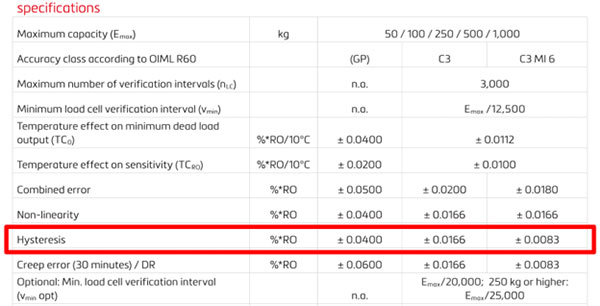
But make sure that you do some research before deciding whether or not to include it in your dubiousness analysis.
How to Reduce Hysteresis
Hysteresis is unavoidable, merely information technology'due south effects tin be minimized.
To reduce the effects of hysteresis, it is common practice to exercise your equipment before use or scale. This means that y'all should load and unload your equipment several times before you use it.
Nearly industry manuals, calibration procedures, and examination methods recommend this do in an effort to reduce the effects of hysteresis.
Take a expect at the excerpts beneath. I take compiled statements from several manuals, methods, and procedures that recommend exercising equipment prior to apply.
CDI Multitest Transmission: Torque Wrench Calibration

CDI Multitest Manual: Torque Transducer Calibration

Heise CM Pressure Guess Manual: Utilize and Calibration

ASTM E74: Calibration and Verification for Strength-Measuring Instruments
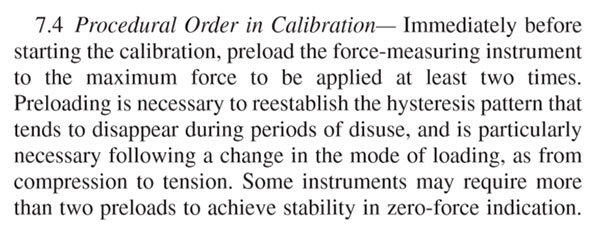
NAVAIR 17-51MP-006: Hydraulic and Pneumatic Pressure Gauges and Switches
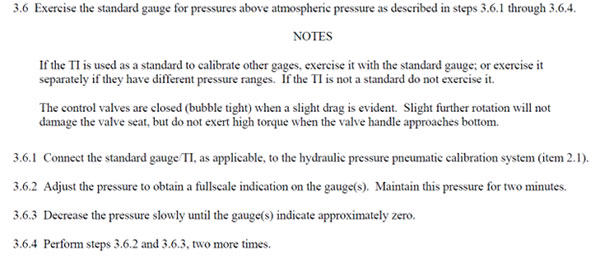
If you are using equipment that may be affected by hysteresis, you lot can minimize the effect by exercising the equipment before utilize or calibration. Following the statements to a higher place, it appears that it is all-time practice to practice equipment for a minimum of 3 cycles (loading and unloading) before it is used.
Formulas to Calculate Hysteresis
When you need calculate hysteresis for your uncertainty budgets, there are ii methods that you can utilise.
Method 1: Maximum Departure Betwixt Upscale and Downscale
![]()
This method is the nigh common. You lot will find it published in many documents, including:
- NCSLI RP-12: Determining and Reporting Measurement Uncertainties
- NIST SEMATECH Engineering Statistics Handbook

This equation takes into account the differences between loading and unloading across the entire measurement range. The benefit to this method is that you will find the maximum hysteresis mistake no matter where it occurs in the range.
Even so, the trouble with this method is yous may confound bias and linearity which volition cause you to overstate your estimated incertitude.
Method two: Difference Between Upscale and Downscale at Midscale and Zero.

This method is less common than the first method. I plant it in the MSL Technical Guide 25: Calibrating Balances several years ago and decided to give it a try.
Today, MSL has replaced this formula in their Technical Guide 25, but I even so prefer to employ it sometimes. I like the method because it takes changes at zero into account.
Yet, it only evaluates hysteresis at midscale. This tin be a trouble since the maximum deviation does not always occur at midscale. Brand certain that you accept that into account when using this equation.
How to Perform a Hysteresis Test
Performing a hysteresis exam is non very difficult every bit long every bit you have the equipment. Only follow the instructions below.
Otherwise, yous may already have the data in 1 of your calibration reports. If then, there is no need to perform this exam. You can proceed to analyzing data.
Method 1: Maximum Difference Between Upscale and Downscale
ane. Select an item for hysteresis testing (due east.thou. scale, pressure level gauge, etc.)
two. Select equipment for making comparisons.
iii. Exercise equipment equally necessary earlier testing.
4. With no load applied, nil the unit of measurement nether examination and record the outcome.
5. Incrementally increase the load (east.g. 10% increments) on the unit nether test and record the effect later each stride.
6. Incrementally decrease the load (e.g. ten% increments) on the unit under test in the reverse social club and tape the upshot after each step.
7. Analyze the results.
Method 2: Deviation Between Upscale and Downscale at Midscale and Nada.
1. Select an item for hysteresis testing (e.grand. calibration, pressure gauge, etc.)
2. Select equipment for making comparisons.
3. Exercise equipment as necessary earlier testing.
4. With no load applied, zilch the unit under exam and record the event (yZ1).
5. Load the unit nether test to 50% of full-scale and record the issue (yH1).
6. Load the unit nether examination to 100% of full-scale.
vii. Reduce the load on the unit of measurement under test to 50% of full-calibration and record the result (yH2).
8. Reduce the load to zero and record the outcome (yZ2).
9. Analyze the results.
How to Calculate Hysteresis
If you have measurement results from in-house testing or a calibration report, you are ready to summate hysteresis. Merely select the method that you would like to apply for analysis and follow the instructions below.
Method one: Maximum Difference Betwixt Upscale and Downscale
ane. Create a table.
Create a table in Microsoft Excel similar to the ane in the image below.
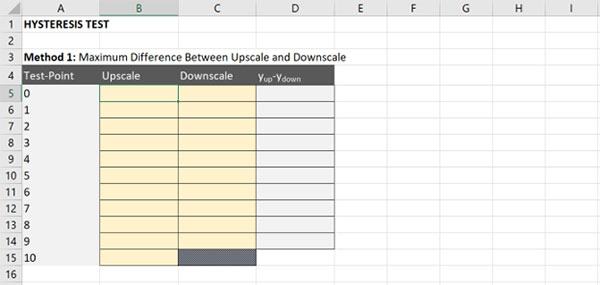
2. Enter your upscale results.
Enter the results of your upscale examination in the upscale column.
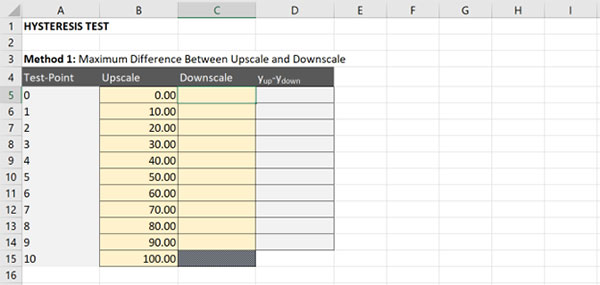
three. Enter your downscale results
Enter the results of your downscale examination in the downscale cavalcade.
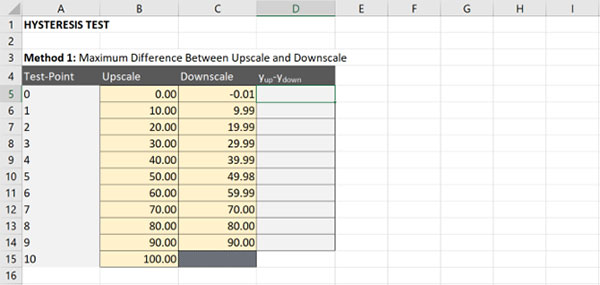
4. Subtract the upscale issue (yupscale) by the downscale result (ydownscale).
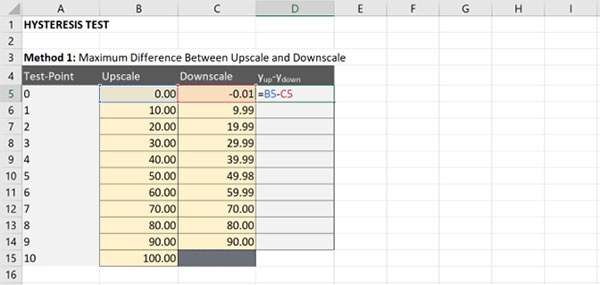
v. Find the accented value of the result in step 4.
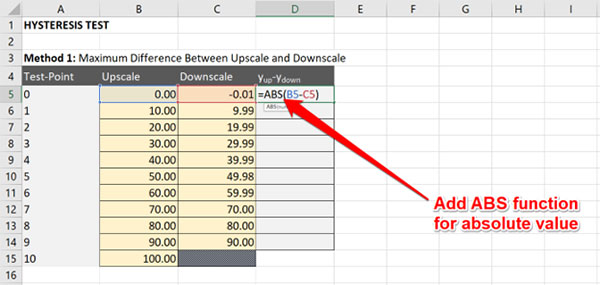
half dozen. Repeat Steps four and 5 for each measurement with results both upscale and downscale.
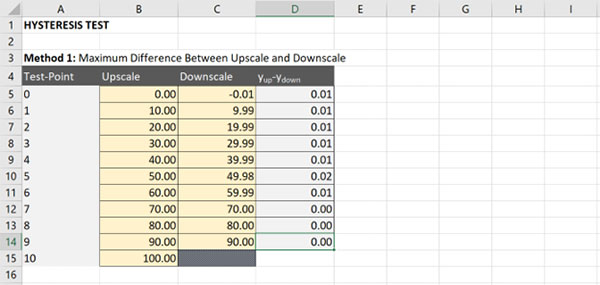
vii. Find the result with the largest (i.e. maximum) departure.
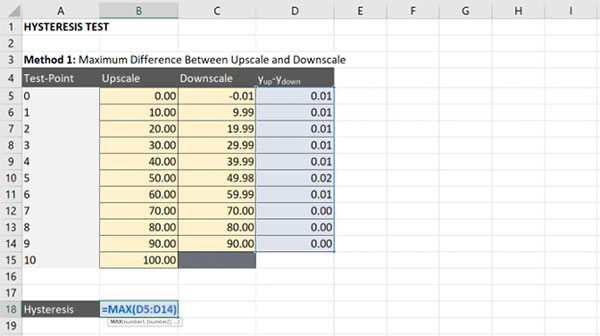
Your Issue for Hysteresis
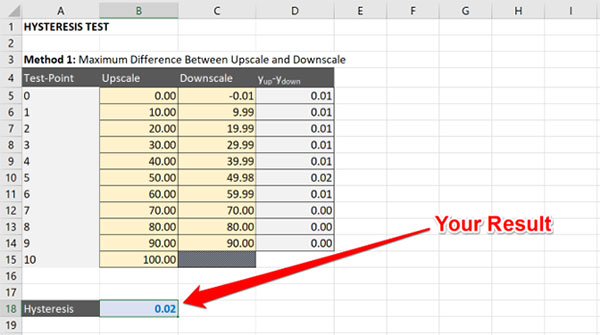
Method 2: Difference Between Upscale and Downscale at Midscale and Zero.
1. Create a tabular array
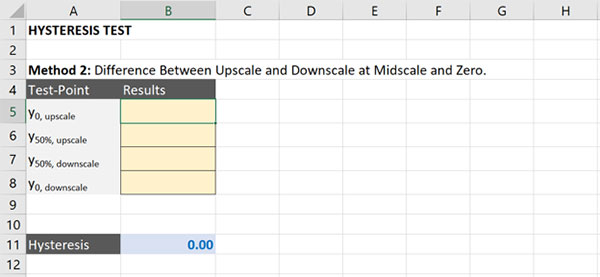
two. Enter your upscale results.
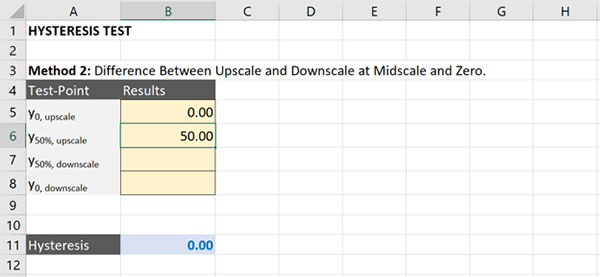
iii. Enter your downscale results.
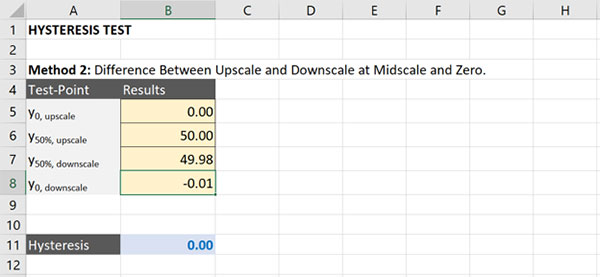
4. Subtract the upscale event (y50%,upscale) by the downscale result (y50%,downscale).
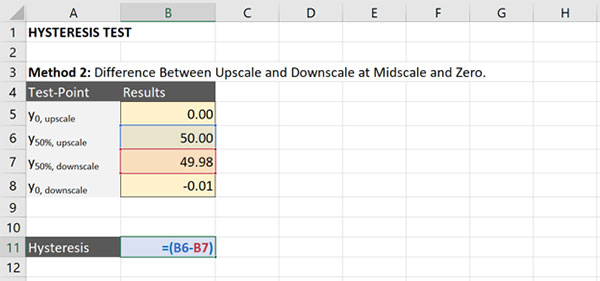
5. Subtract the upscale result (y0%,upscale) by the downscale result (y0%,downscale).
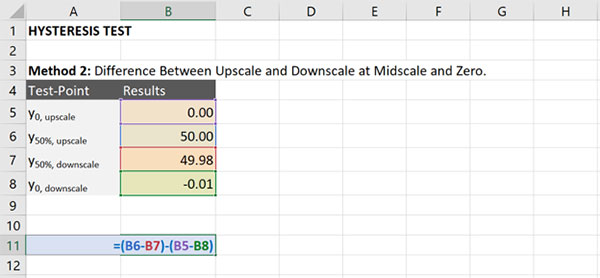
six. Divide the result from Step 5 by iii (i.e. 3).
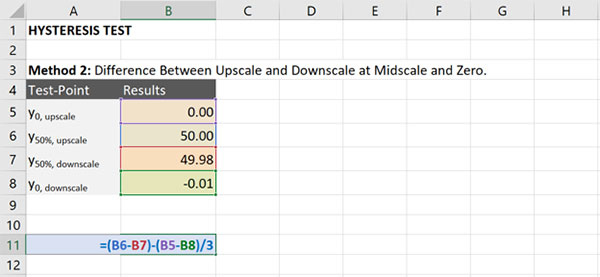
7. Decrease the outcome from Step four by the result from Step 6.
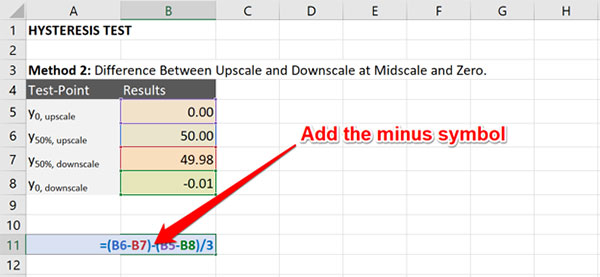
Your Result for Hysteresis
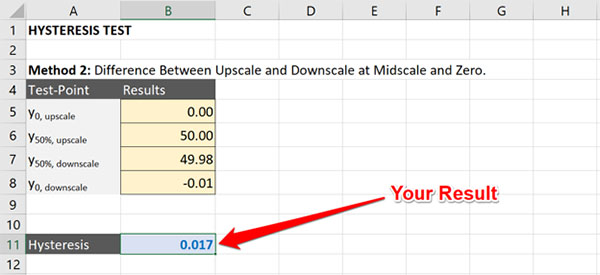
Conclusion
Hysteresis is a source of dubiousness that is considered to exist important by many but not included in near doubtfulness budgets. Many methods and procedures give instructions to help reduce hysteresis, but you most likely will not be able to eliminate information technology. Therefore, you should give information technology consideration in your uncertainty analysis and include information technology in your uncertainty upkeep if it is applicable.
This guide has given yous a lot of information about hysteresis; what is it, why is it of import, and when to include it in your uncertainty budget. Additionally, you lot should have learned how to perform a hysteresis test and how to analyze the results for uncertainty assay.
With this data, y'all should be able to hands calculate hysteresis and add it in your uncertainty budgets.
Source: https://www.isobudgets.com/how-to-calculate-hysteresis/

0 Response to "How To Calculate Hysteresis In Matlab"
Post a Comment